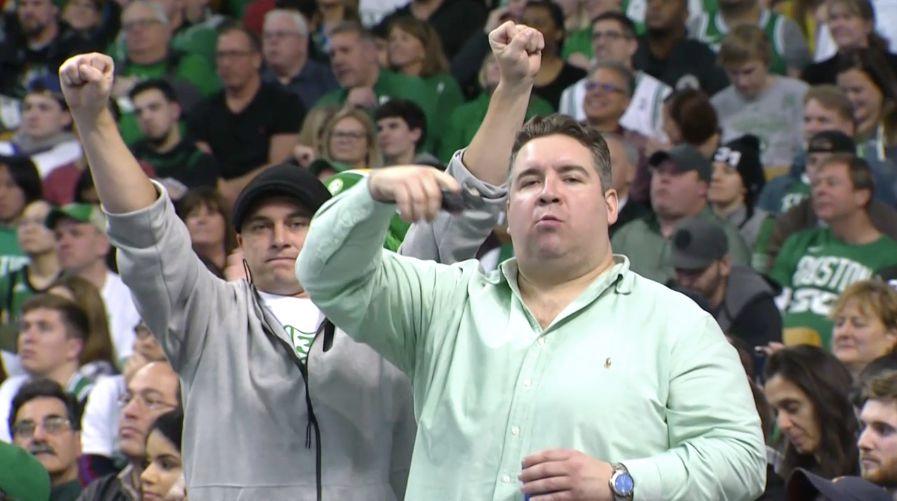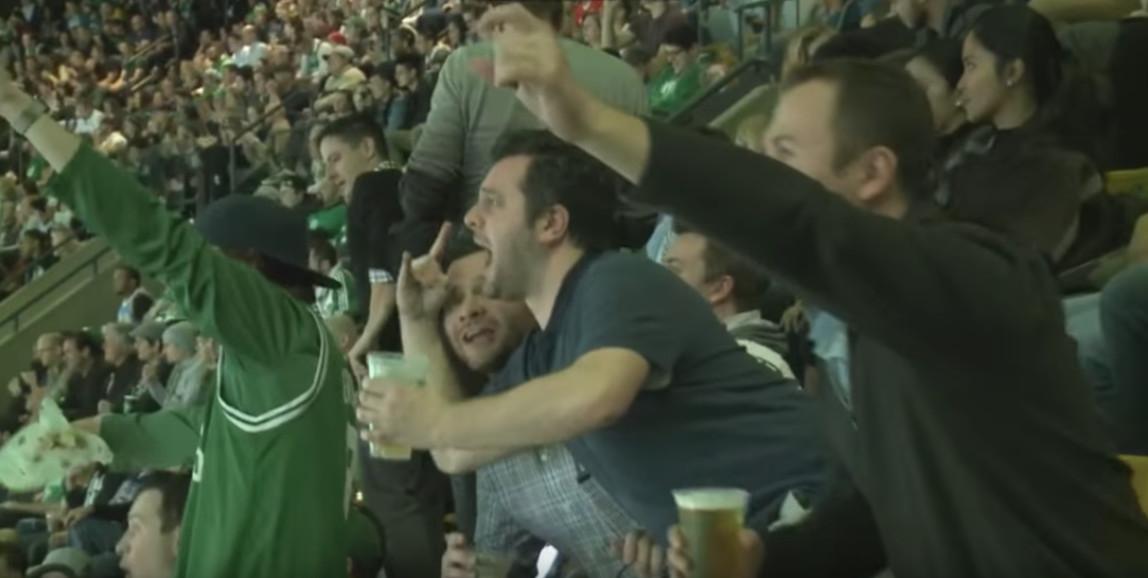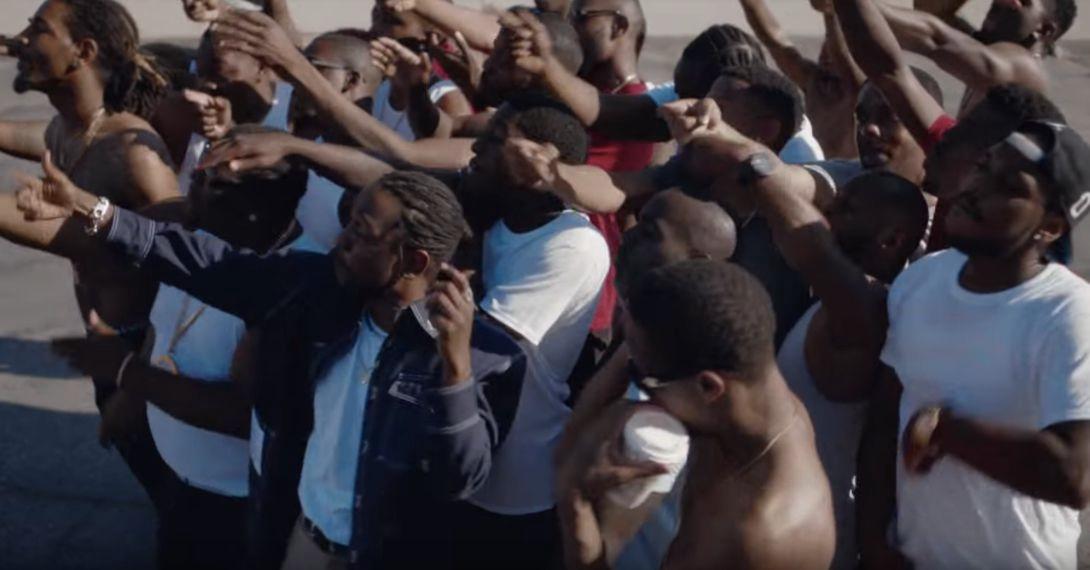A timeout is called in the second quarter of a nondescript NBA game between two teams that won’t see May basketball, and the cameras turn to the fans, where the real action is. A man, dressed in textbook dad wear, dances in a two-step shuffle to the good-time rhythm of Pitbull. He’s gaining momentum: The moves aren’t getting any better, but the hip-swaying and first-pumping is definitely getting bigger, and the camera is drawn to the genuineness of his Elaine Dance. He looks up to the Jumbotron—the great, panoptic console from the dreams of Sony shareholders and nightmares of Orwell—and oh, god, he sees himself. All dance motion freezes. His eyes flash an animal fear, and, if you’re within a couple of rows of our dancer, you might smell the initial volley of nervous sweat.
The interaction lasts at most a second, but watching on the Jumbotron, we are stranded in time with him for much longer. Any moment looking into a person’s eyes feels extended, immediately personal, but when it’s a look of fear among thousands of strangers, it’s a deep reveal of the human soul. Why flounder for the attention of your neighbors in a very large building if you can’t dance? Why do we seek out what we are afraid of? What is it like when we get what we want?
I spend a lot of time watching the NBA online, where NBA League Pass, or, more conspicuously, r/nbastreams, broadcasts the dance cam and other in-stadium treats in the space where commercials should be. Watching from home, the human theater of fan dancing is magnified, as if viewing on a laptop screen turns the audience into entertainment; a time-killing timeout activity becomes prestige drama, or at least something you’d find on the YouTube channels you have to pay for. Yes, I still wanna watch hoop, but I also want to see a pair of ovate Rockets fans with pro-am choreography get after it against a dad twerking without reservation and a woman doing the backpack-kid dance.
At its core, the appeal is the same as people-watching: a randomized encounter with someone in a public space becomes a daydream into their perceived life. To take a screenshot feels almost invasive, like making eye contact with a stranger on the train when taking a picture of their look.
In my wholly unscientific survey of the fan cam, there are six orders of dancers, each with multiple subcategories. Think of it as an indoor astrology chart: It might not align perfectly with every personality, but all traits are contained within this study of movement.
1. The No-Thank-You Dad. This is my dad. This person has a profound disinterest in the sideshow of Jumbotron entertainment. The camera will come to them, “Stir Fry” wafting in the air, and their arms will not uncross for us. Their eyes sing with indifference. This is a person who does not falter from their mission. Today’s mission: Eat a big pretzel and watch the Nets lose.
2. The Fist-Pumper. The least-concern species of NBA fans, they’re found in all stadium environments, from five-figure floor seats to nosebleeds that cost less than the fees on StubHub. The gesture itself is flawless, to throw your hands in the air is a universal statement of victory and power: Our team will not lose, I will pound this $13 Bud Latte, and yes, I will have another. This move is popular in Boston. (Despite the subjective nature of this project, Celtics fans, present company included, are objectively the worst dancers of all surveyed.)

3. The Monitor Mobber. Perhaps the most revealing decision in this exchange is between staring into the camera and staring at the Jumbotron: to give everything to the audience, or to enjoy an oblique angle of yourself on a big-ass TV. When people mob to the monitor, the camera moves on instantly, as it’s not particularly interesting to watch the side of a dude’s face.
But there is a How It Works moment at play here. These dancers remind us that there is no dance without the Jumbotron, that it’s all a performance for the camera. On “Element.,” Kendrick Lamar’s Gordon Parks–nodding video from Damn., he considers the same theme. From the side, we see how hollow the display is, that they’re just going ham in an otherwise quiet mezzanine or empty parking lot.


4. The Entertainer. “You feel like you’re fucking famous,” said one of these dancers, of the post-camera glow. “I always want more.” Here are the Leos of the function, capable dancers with moves lined up to maximize their time in the sun. The intention is premeditated, as the dancer lets us in: “If you’re close enough to the camera, you can see a red light pointing at you if it’s going to be on you.” It’s an inside talent, like reading a pitch, that allows the best in the game to prep their movement. For inspiration, see the Bon Jovi populist, the Christmas-sweater Warrior, and the KG-endorsed Jiggly Boy and his sons.
5. Attention Turns to Fear. The Icarus moment of the dance camera, when expectation meets reality. Dr. Peter Lovatt, the founder and head of the Dance Psychology Lab at the University of Hertfordshire, chalks it up to the experience of suddenly seeing yourself in real time. People who love dancing love the “neural kick” of seeing themselves dance; it’s why dance studios have mirrors. People who aren’t comfortable in their movement experience the opposite effect. “It’s like hearing yourself sing,” says Lovatt. “You think you’re doing fantastic, then you see yourself on this big screen and you go, ‘Wow, is that me? Is that really how I look to other people?’ The message you believe you’re communicating isn’t the message you’re communicating at all.”
To help end this scourge, Sharon McCoy, a 60-year-old veteran of the New Orleans Pelicans Senior Dance Team, recommends a few major plays from her repertoire. Their strengths are in their simplicity, moves that can override a full-body panic: the Carlton, the Bernie, the Sprinkler. “I say just get on the floor and shake your body.”
6. The Genuine Bad Dancer. “If somebody stands up and starts doing a certain dance routine that they’ve learned, it might look overlearned, less natural, less interesting to watch,” says Lovatt.
It’s why, from the laptop screen, the prearranged routines of cheerleaders don’t land—excluding the life-affirming Dougies of NBA senior teams.
It’s the raw joy of a bad dancer that captures the eye from home. Similar to the rules of improv, where trying too hard can kill a scene’s energy, the best of the NBA fan cam is an exercise in authentic movement. Lovatt calls it “natural, responsive dancing,” the kind we do when we are alone. “When you’re seeing people just grooving in an uninhibited way, an audience will be drawn to watch them because they see that it’s a natural form of movement.”
It’s my new favorite TV show, too. Give me the flailing masses yearning to move freely; the children dabbing to-and-fro, their parents half-twisted with hands in the air; the bliss of recognition and fear of failure in strangers’ faces; the uncomfortable learning to move in their bodies, the confident showing the way. It’s inspiring for a shy guy like me—a biweekly, beer-in-hand amateur—a reminder that good dancing doesn’t mean dancing well.
Matt Stieb is a fact-checker at New York magazine.